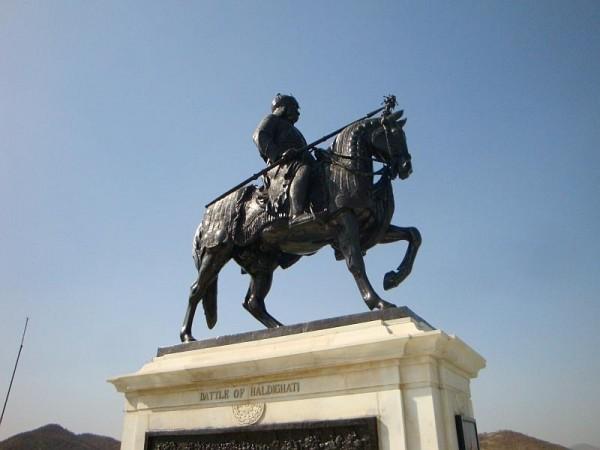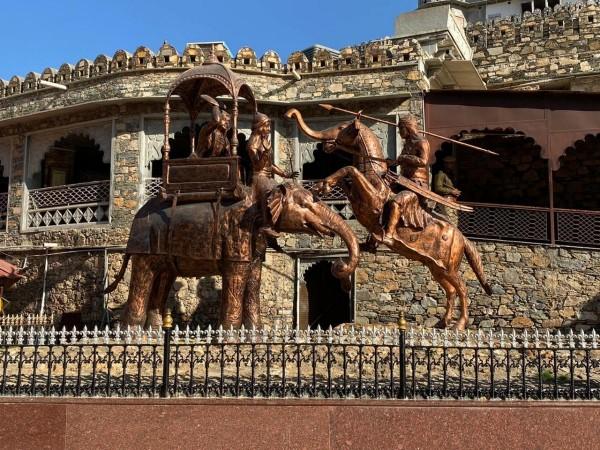Today, May 9, marks the 480th birth anniversary of one of India's most revered warrior kings – Maharana Pratap of Mewar. A synonym for valour and patriotism, Pratap is arguably the most celebrated figure in Rajasthan's history and one who has been hailed as the greatest icon of Rajput chivalry.
Pratap is remembered for defying the all-pervasive Mughal authority of Emperor Akbar at a time when the latter was at the zenith of his power and had subdued most of the Indian kingdoms north of Vindhyas. This was also the time when all other kingdoms of Rajasthan, almost without exception, had allied themselves with the Mughal might.
But Pratap, defying repeated military incursions and various offers of a treaty, remained independent till the very end of his life. On his birth anniversary, let's look back at the most interesting features of the life of this famous king.

Family background
Pratap was born into one of the most revered royal houses –Sisodiyas of Mewar, a relatively fertile region of Rajasthan. This dynasty was established by Bappa Rawal in eighth-century and claimed its descent from Lord Rama. The royal house of Mewar boasted of various celebrated rulers like Rana Hammir, Rana Kumbha, Rana Sanga, etc.
Pratap was the grandson of Rana Sanga who had battled against Babur when the latter was in the process of strengthening his rule across North India after winning the first battle of Panipat in 1526. The son of Sanga's successor Rana Udai Singh II and his first wife Jaywanata Bai, Pratap was born in the celebrated fortress of Kumbhalgarh in Mewar.
During Pratap's lifetime, Rana Udai Singh II was forced to leave the celebrated fortress of Chittorgarh – the long-held and celebrated seat of Mewar's royal throne – after it was besieged by Emperor Akbar in 1567. The fort fell after a heroic defence by Rajput warriors and was never recovered by the Mewar dynasty.
Udai Singh was then forced to shift his capital and established the city of Udaipur which remained Mewar's capital till its amalgamation into the Indian republic.

Early troubles and accession
Being the eldest son of Udai Singh and widely regarded as the most able among his progeny, Pratap was widely accepted to be the inheritor of Mewar throne. However, Jagmal, a step-brother of Pratap was chosen by his father to succeed him. Pratap accepted his fate and left the fort of Gogunda where his family was then residing.
However, the royal courtiers, realizing that Pratap, not Jagmal, was the rightful inheritor of the Mewar throne, physically removed Jagmal from the throne and asked Pratap to take his rightful place. The coronation of Pratap took place near the fort of Gogunda where the family was then based. He became the 54th ruler in the celebrated Sisodiya dynasty.

Battle of Haldighati
Pratap was now faced with the onerous task of keeping his kingdom independent in the face of the Mughal assault. He refused to accept Akbar as his overlord and rejected an offer of alliance made by the Emperor through the Kunwar (Prince) of the house of Amber Man Singh.
This resulted in the famous battle of Haldighati, fought in 1576, where the forces of Pratap clashed with Mughal Army led by Man Singh. Leading an army of Rajputs, reinforced by Pathan warriors of Hakim Khan Sur and tribal Bhil warriors under the leadership of Rana Punja, Pratap performed gallantly. But the early advantage that his army had was lost as the Mughal Army rallied and pushed the Rajputs on the defensive.
Eventually, on the advice of his followers, Pratap decided to withdraw from the battlefield and live to fight another day.
Change of tactics
Having lost many of his leading warriors, Pratap decided to change tack. He started living in the forests of Mewar along with his family and adopted the strategy of guerrilla warfare against the Mughals. Stories abound of the spartan and rough life that the King of Mewar had to live in the forests, shorn of all the luxuries a royal family is used to.
But the guerilla tactics proved to be very useful. Avoiding pitched battles, Pratap's warriors repeatedly expelled the Mughals from the stations they used to establish in Mewar and never allowed the Emperor's forces to take over the entire area.
The Maharana strengthened his hold over Mewar through a great victory in the Battle of Dewair, fought in 1582, over the Mughal forces. After this key victory, Pratap was able to live in relative peace and the pressure from Akbar also became lessened.
Pratap now ruled over most of Mewar and settled down to a less peripatetic existence. His last years were comparatively peaceful but tinged with the disappointment of not regaining the celebrated fortress of Chittor – the most revered of all the seats of power in Mewar's history.
Death and legacy
Maharana Pratap breathed his last on January 19, 1597, at the age of 57, after suffering an injury during a hunting expedition. He had managed to keep his state free and in good economic health through his perseverance and undying spirit of freedom.
He was succeeded by his son Amar Singh who continued his father's policy of defying Mughal authority. However, in 1615, after unceasing withstanding unceasing invasions by the Mughal forces into Mewar, Rana Amar Singh was forced to conclude a treaty with the then Mughal Emperor Jahangir.
However, the Mewar rulers were able to earn the right to not present themselves at the royal court in Delhi, thereby continuing the symbolism of freedom. In 1911, when King George V held a royal durbar in Delhi as the Emperor of India, the then Rana of Mewar exempted himself from being present at the event, as a continuation of Mewar's legacy of not bowing down to royal authority.









!['Had denied Housefull franchise as they wanted me to wear a bikini': Tia Bajpai on turning down bold scripts [Exclusive]](https://data1.ibtimes.co.in/en/full/806605/had-denied-housefull-franchise-they-wanted-me-wear-bikini-tia-bajpai-turning-down-bold.png?w=220&h=138)



